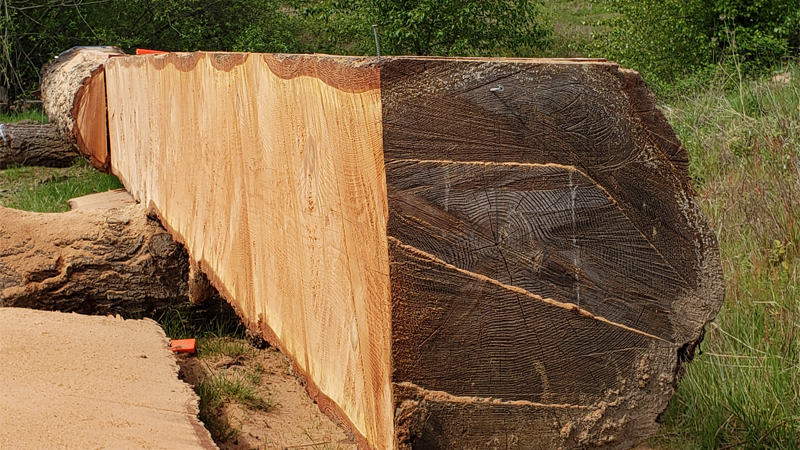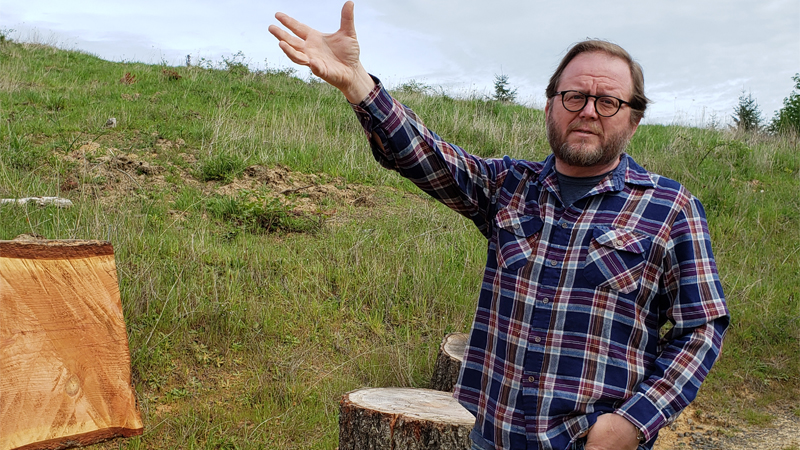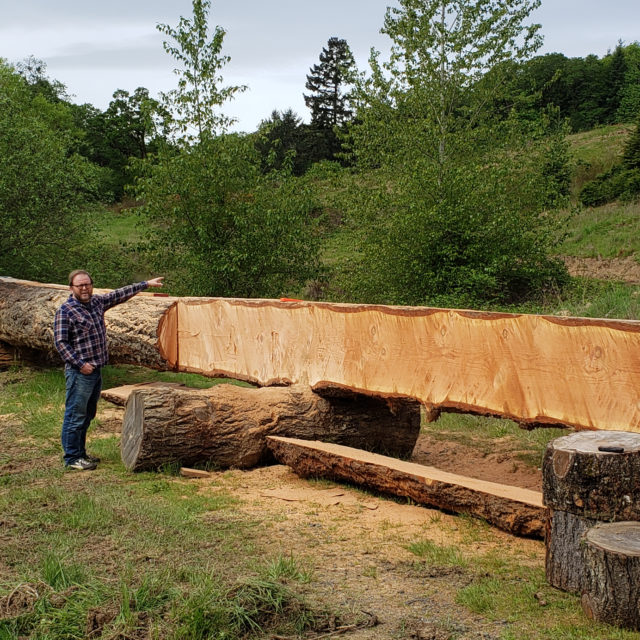Brad Ford, the winemaker at Oregon’s Illahe Vineyards, is always tinkering with something interesting — a wine press rescued from a junkyard, a horse-drawn mower he engineered himself, amphorae he created from scratch. The need to make or restore his own tools has been driven out of financial necessity at times, as is the case for many small wineries. But it also fulfills his desire to explore every aspect of the art, science, and mystery of his profession.
In the lull provided by the Covid-19 outbreak, Ford has embarked on his biggest project yet: building a beam-style wine press similar to the one the Roman scholar Cato wrote about in “De Agri Cultura.” When finished, he expects the 1-ton, 60-foot press will be the longest in the United States.

The 19th Century Reimagined
Ford’s father was a hobby grape grower who began operating a vineyard professionally in 2000. Ford became the winemaker at his dad’s company about six years into the new venture and now runs all the day-to-day operations. Although he attended the wine studies program at nearby Chemeketa Community College to learn the most modern information about winemaking, he felt himself drawn to the history of farming and enology. Early on, he began to experiment with more traditional approaches to creating wine.
To begin with, he bought two draft horses, Doc and Bea, to work on the property. The team cuts the vineyard’s cover crop and transports some of the fruit during harvest. Their role is limited by the fact that teamsters are in short supply today, so Ford is the only one who knows how to drive them. Even if horses aren’t the most efficient way to farm, Ford is committed to the method. “It is really enjoyable to be around horses,” he says. “It’s way more enjoyable to be working with animals than with tractors. You get a huge human benefit out of a lifestyle that’s more ancient and natural.”
Doc and Bea also play a crucial role in one of Ford’s signature wines, the 1899 Pinot Noir. Most years he makes eight to 12 barrels of wine without the aid of electricity, stainless steel, or other conveniences invented after 1900. The grapes for the wine come from a 1-acre block that is harvested exclusively with the horses. The fruit is de-stemmed with a bicycle-powered machine, pressed in a wooden basket press, fermented with natural yeast in a wooden vat, and pumped into barrels with a bicycle-powered pump.
Even transporting the wine to Illahe’s Portland-based distributor is typically done without the aid of electricity. The boxes are moved off the property by horse and loaded into a stagecoach that delivers the wine to the nearby Willamette River. There, it’s placed in a canoe. Ford and two others spend three days paddling to Oregon City, where the boxes are transferred to a bicycle for the final leg of their journey.
While that final piece has more to do with Ford’s desire to be true to his experiment, he says he’s learned a tremendous amount about winemaking through the 1899 project, including how to work with the native yeast that he now uses exclusively in all of his reds.
“Science is one way to go about things and I love science,” Ford says. And he has no objection to using modern knowledge to help the vineyards stay healthy or remove flaws from wine. But the best foods aren’t the ones that are highly processed or made in a lab, and he believes the same is true for wine.
“Every experiment we’re doing is moving us forward to more historical winemaking than modern, scientific winemaking, and more natural winemaking,” he says. “It just produces the best wines.”

Remaking Cato’s Wine Press
The extreme end of Ford’s desire to return to old-school winemaking is his latest project: a beam-style wine press that will be 60 feet long when it is finished. Millennia before today’s electric presses were invented, Cato and other winemakers juiced their grapes by lowering a heavy object such as a beam onto a wooden basket full of grapes. The next innovation was a screw press, which allowed people to twist one or more handles to apply force to the basket.
Ford had seen a hand-carved wooden screw press at Château du Clos de Vougeot in Burgundy. “It’s one of the things I really remember from that visit,” he said. “The wine is something I remember quite a bit, too, but coming to a place and seeing that press was an important experience for me. So if we can recreate a little bit of that experience, I’d like it.”
Despite his fascination with the Burgundian screw press, Ford decided that Cato’s beam press would be easier to build. He also knew it would be more authentic than what he was currently doing with the 1899: moving the pistons on a modern-day basket press with hydraulic auto jacks that two people had to pump by hand. (“They’re filled with hydraulic oil. Did the Romans have that? No. But are they electrical? No.”)
Ford’s closest friend is Erik Jensen, a physics instructor at Chemeketa Community College. Ford asked him how big a beam he would need to operate a basket press that could handle his current grape production. “He did his math and said it needed to be 60 feet long. He’s since retracted it but it’s too late because now I’m building the thing.”
To begin the press, he cut down a dying 130-foot Douglas fir tree on his property. He called a local lumber mill to see if they could transform it into the beam. The answer was a resounding no. Log trucks can only move trees up to 50 feet, and most mills can’t handle one longer than 24 feet. “I said, ‘What would you do if you were trying to build a big beam that’s 60 feet long?’ and they said, ‘I’d use a chainsaw,’” Ford said. His next stop was the local logging store.
It took a 7-ton excavator to stand the tree up on two smaller logs so he could cut it to size. Ford built a carriage for the chainsaw that runs along a 2-foot-by-8-foot length of timber attached to the top, and is using a string line to trim off the curved sides of the log. When finished, the beam will be 14 inches wide at the narrowest end and 2 feet on the opposite side. (The cut-offs from the log will likely go to the tasting room, where they’ll be finished and turned into tables.)
At some point, Ford will also build a wheel that can be connected to the beam with a rope, then cranked to lower or raise the beam manually. It will operate a press about 6 feet wide, which will give Ford about four times more pressing capacity than he has now. It will also work faster; given the beam’s incredible weight, the press cycle should only take about an hour.
The disruption caused by the Covid-19 outbreak has given Ford extra time to work on projects around the winery. He hopes to have the beam cut and moved to the exterior alcove where the presses are located later this year. It will take years to fully finish it. “If we really like it, we’ll build it a little house,” Ford says fondly, looking at the log. “It will be so fun for people to go outside and have a glass of wine and see the press.”
He acknowledged that building this modern wonder makes no economic sense. “You can easily buy something so much faster that already works and that’s controlled by a computer and that does a great job of pressing the wine,” he says. “But it’s so much less fun to just buy a brand new press.”
It also wouldn’t teach him anything about winemaking. As he stands in the clearing where the log is undergoing its transformation, Ford talks about the Japanese craftsmen who adopt an art form at a young age and spend the rest of their lives refining their skills and understanding their art. “They make their own tools,” he points out. “You make your own knife, you make your own saw, you make your own pots or whatever you’re going to use for your craft. You have your tools and you know those tools are always sharp and those tools are the ones you need for the job.”
A beam may be slightly bigger than a carving knife, but Ford believes it will help him further shape and hone the medium he’s dedicated his life to.
